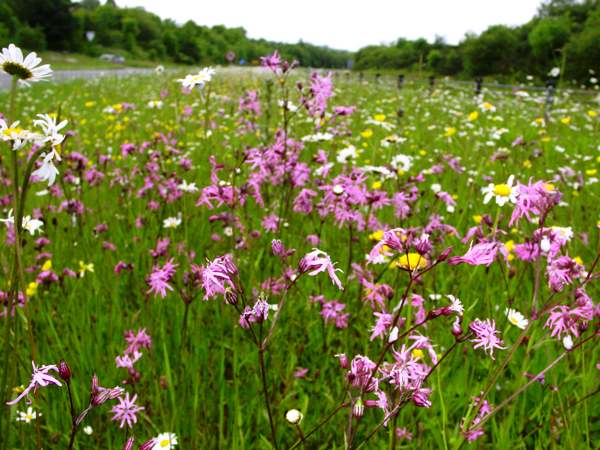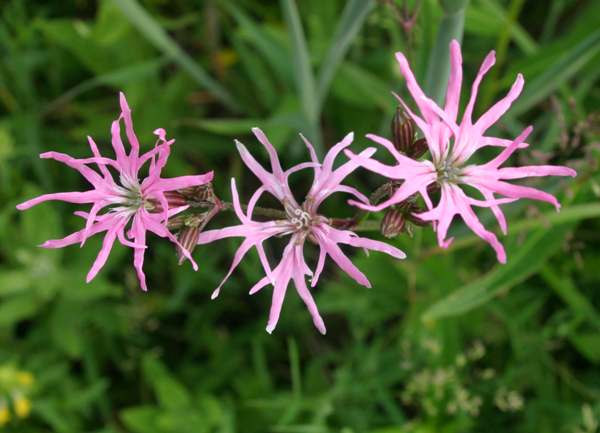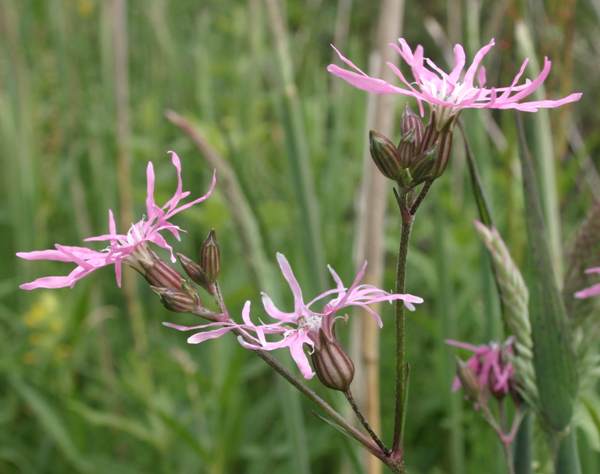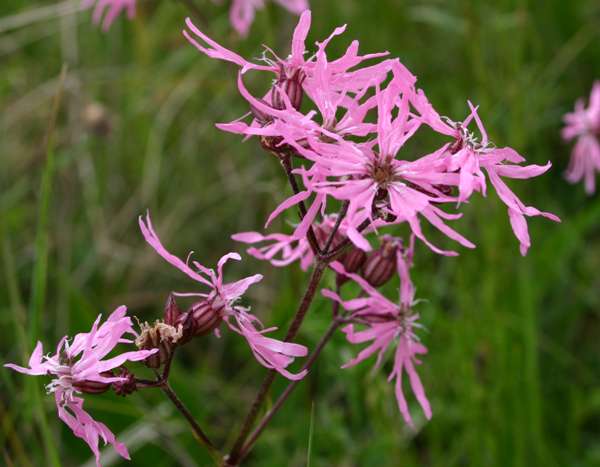Lychnis flos-cuculi - Ragged Robin
Phylum: Magnoliophyta - Class: Equisetopsida - Order: Caryophyllales - Family: Caryophyllaceae

It is surprisingly difficult to capture the true colour of this flower in a photograph: the pink has far less of a blue component than that of Red Campion Silene dioica and is more like the bubblegum that many of us chewed as children.
Description
The pink flowers are 3 to 4cm across with five petals each deeply divided into four narrow lobes; this gives the flowers an untidy, ragged appearance - hence the common name Ragged Robin.

Stems of Ragged Robin are hairy and can grow to 80cm in height, and the untoothed opposite leaves on the upper stems are stalkless, narrow and lanceolate, with a few spoon-shaped stalked leaves lower down. The leaves are rough to the touch.
Distribution
Although it is quite a common wildflower Ragged Robin is rather localised in Britain and Ireland. We have seen it in many parts of northern and central mainland Europe including Slovenia.
Habitat
Ragged Robin usually inhabitats damp or marshy areas, although once established it seems able to grow surprisingly well even on some dry and exposed roadside verges. In marshy locations this plant often spreads across large areas, but for the most part it is more sparselydistributed than its relative Red Campion.

In Britain and Ireland this lovely wildflower is in decline due to land drainage, which has destroyed much of its favoured marshy habitat.
Blooming Times
This aptly named wildflower produces its ragged and often rather bedraggled-looking blooms mainly in May and June although a few flowers sometimes hang on in damp, shaded spots through July and sometimes into early August.
Etymology
Lychnis, the genus name, comes from the Greek noun lychnos, meaning lamp; it refers to the use of a plant in this genus as the wick of an oil lamp. The specific epithet flos-cuculi means 'flower of the cuckoo' and was probably chosen because the first flowers of Ragged Robin appear just as the first cuckoos are being heard (in Britain and Ireland at least) in May.

Uses
Ragged Robin is sometimes planted beside garden ponds for its ornamental value. We are very pleased with the display of Ragged Robin beside our own small wildlife garden pond in West Wales.
The roots of these wildflowers are a source of saponin, a soap substitute than can be used for washing clothes or as a shampoo etc. Saponin is toxic, although not readily absorbed by the human body; it affects some creatures more than others and has in the past been used by hunters (and probably poachers) to stun or even to kill fish in ponds and small streams.
Varieties
Occasionally you may come across an all-white variety of Ragged Robin, but pale to mid pink is more normal.

Similar Species
From a distance Ragged Robin is easily mistaken for Red Campion Silene dioica, which has broader petals each with a single narrow cleft. Red campion grows in generally drier habitats such as under hedgerows and on woodland edges.
Silene colorata is a Mediterranean species with smaller pink flowers that are more deeply notched; it also has a less robust growing habit and favours dry sandy soil.
The pictures of Ragged Robin shown on this page were taken in June in Newborough Warren National Nature Reserve in Anglesey, North Wales, Llangloffan Fen National Nature Reserve in Pembrokeshire, Crosshands in Carmarthenshire, Rhydlewis in Ceredigion, and in May in Slovenia.
Sue Parker's latest ebook is a revised and enlarged second edition of the acclaimed Wildflowers in the Algarve - an introductory guide. Full details here...
Buy it for just £3.95 on Amazon...
Please Help Us: If you have found this information interesting and useful, please consider helping to keep First Nature online by making a small donation towards the web hosting and internet costs.
Any donations over and above the essential running costs will help support the conservation work of Plantlife, the Rivers Trust and charitable botanic gardens - as do author royalties and publisher proceeds from books by Pat and Sue.



